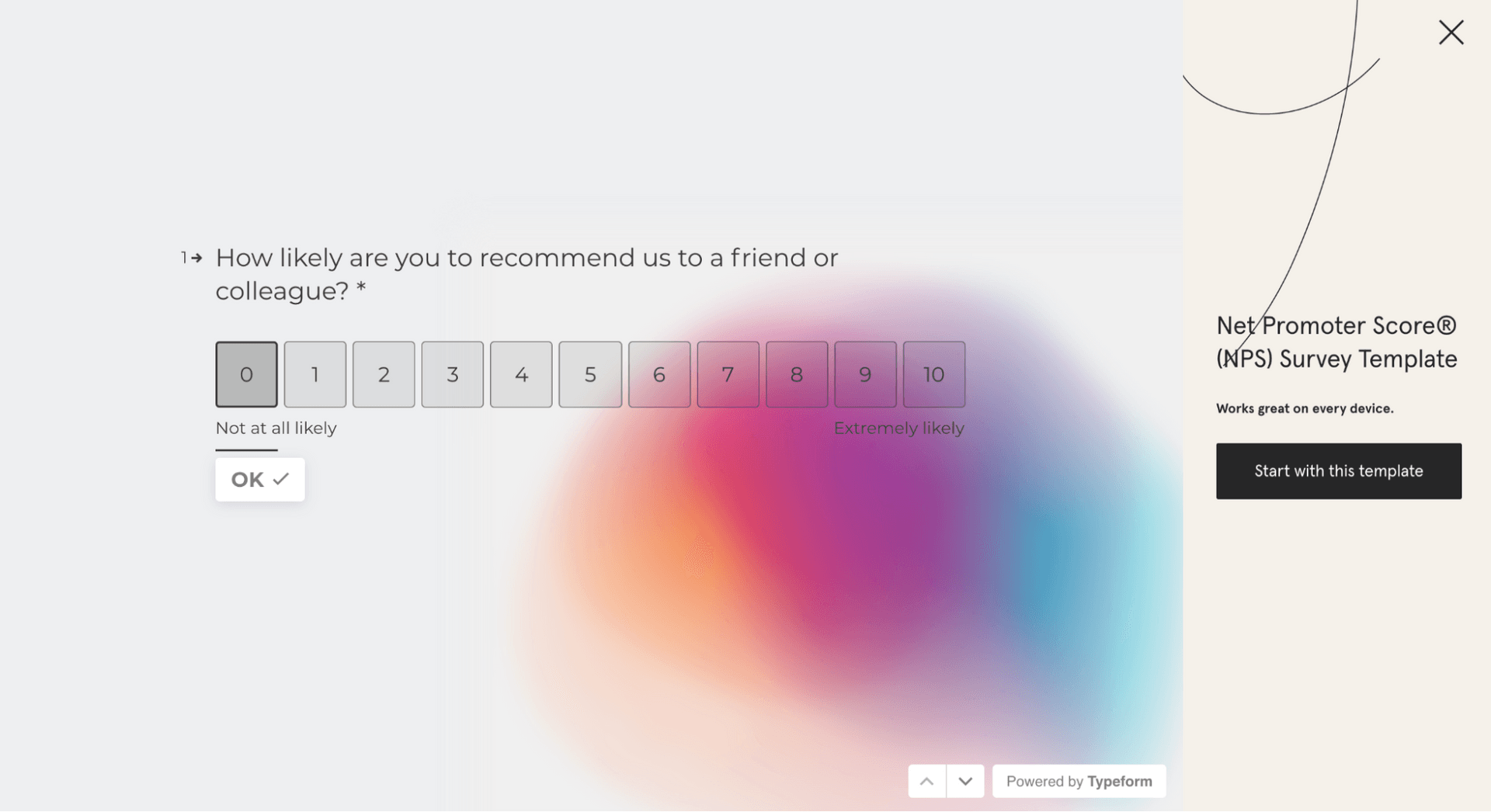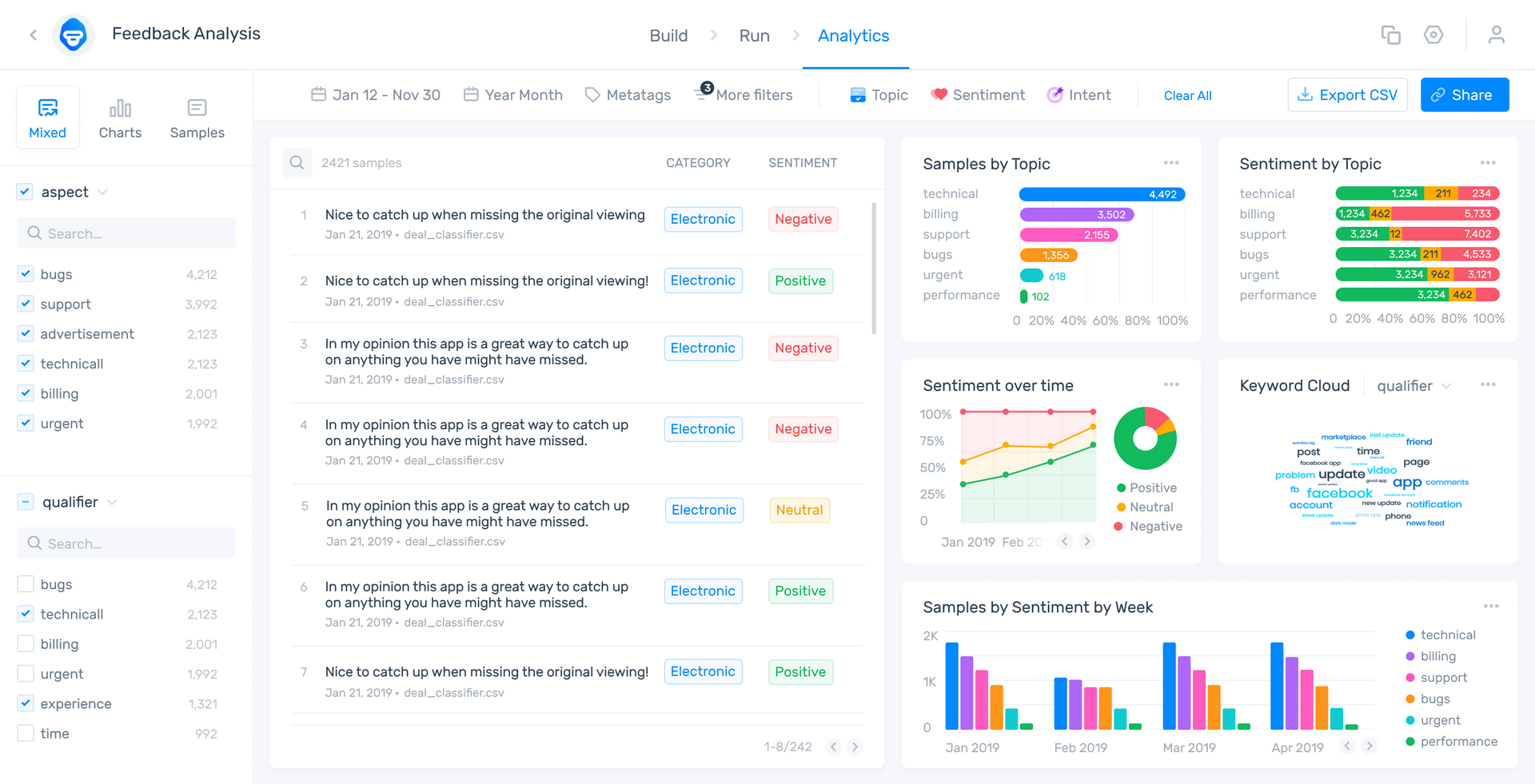Net Promoter Score Template and Survey Question Ideas

Your Net Promoter Score is a must-have when it comes to customer service metrics. It’s a quick pulse check on the loyalty of your customers and it lets you know when you need to improve areas of your customer experience (CX).
Loyalty matters. Studies have shown that the probability of selling to an existing customer is between 60% and 70%, whereas the likelihood of selling to a new customer is between 5% and 20%. To hold on to your existing customers, you need to be listening to what they like and what they don’t like. NPS allows you to keep on track of this.
The generic NPS survey question is simple and effective. However, when you begin to tailor your survey, you get more actionable and useful insights from your customers.
In this blog we’ll go through some different survey questions and net promoter score template ideas that you can use to improve your NPS results. You’ll also learn how to use AI tools to better analyze the information you get back from your surveys.
Feel free to jump ahead here to the section that interests you the most:
- NPS Survey Template
- Close-Ended NPS Question Templates
- Open-Ended NPS Question Templates
- Online NPS Survey Templates
- Get Insights From NPS Surveys
- Conclusion
NPS Survey Template
The words you use in your NPS survey questions matter a lot and can impact the responses you get back.
Tweaking your question can change the direction of your customer’s focus and garner different results. We’ll get to this in more detail, but for now let’s start by taking a look at the basic NPS structure.
The NPS survey begins with a standard closed-ended question which asks your customers to rate your company with a score from 0-10.
The NPS closed-ended question is then followed by an open-ended question which asks the customer to expand on why they chose the score that they did.
This open-ended question is qualitative - it gives you extra information on your customer and their experience with your company. This can then be analyzed for important information about your customers’ experience and used to make improvements.
Close-Ended Question Templates
The close-ended question is the backbone of the NPS survey and is essential for calculating your score. There are a few ways you can tailor this question to achieve different aims. We’ll go through some of these here:
Find how customers feel about your company
You’re probably familiar with the classic NPS question:
"How likely are you to recommend us to your friends and colleagues?"
Your customers answer by choosing a number between 0-10, with 10 being the most likely. This question is short, simple and effective, and the responses you get back will give you an idea of your customers’ overall loyalty to your company.
Depending on which number the customer chooses they are assigned the following labels:

- 8-10 Promoters: These customers are your most loyal supporters and will recommend you to their friends and contacts.
- 6-8 Passives: Passives will neither recommend you nor actively discourage their contacts from using your products and services. However, they are not loyal customers and could easily jump to your competitors.
- 0-6 Detractors: These customers are disloyal and would actually tell their contacts not to use their products and services.
Now we’ve looked at the classic closed-ended NPS question, let’s take a look at some alternatives.
Deviating from the standard question will result in different responses from your customers. The original question is great in that it gives you an holistic view of your customers’ loyalty. However, by changing the focus of the question you can hone in on particular areas of your customers experience (CX) journey.
Ask about a particular product or service
For example if you want to see how your customers feel about a particular product, your question might look something like this:
“How likely are you to recommend [product or service] to a friend or colleague?”
Find how your customers feel about your customer service
You might also want to gather information about the experience your customer service team provides. This could mean asking a question like this:
“Based on your recent interaction with our customer service team, how likely would you be to recommend our company to a friend or colleague?”
Find out how your employees rate you as a place to work
Employee NPS (eNPS) is a metric which measures your employees satisfaction levels. Knowing this can tell you how likely your employees are to stay with your organization. It helps you identify your detractors, passives and promoters, and learn why they feel the way they do.
The standard eNPS question is as follows:
“How likely would you be to recommend this company as a place to work to a friend or acquaintance?”
Your employees then answer on a scale of 0-10, just like in the customer NPS.
As you can see, changing the standard question gives you the flexibility to focus your customers’ attention on specific aspects of the process or products and services. This way you can see exactly where they are having issues and what these issues are so that you can put corrective measures in place swiftly.
Open-Ended Question Templates
As we’ve touched on, the open-ended section of your survey is an excellent opportunity for your customers to expand on the reason for their answer for their rating.
When they do this, you get important data from your customers. Because they can respond in their own words. You may even receive completely unexpected, yet helpful, responses.
The default open-ended question is generally:
Explain the reason for your score.
However, to elicit even more information, a second follow-up question can be added. This question can be tailored specifically to target promoters, passives or detractors to segment the data you get back.
Here are some examples:
For Promoters, you could add:
How did we help solve your needs?
Or:
Why would you recommend us?
When you know exactly what it is that makes your customers happy, you can recreate this feeling of satisfaction in other areas. You may even be able to incorporate some of these insights into your marketing campaigns to attract new customers.
Moving on to Passives, you might add:
How or what can we improve to meet your needs?
Or:
What could we do to make you happier?
By asking your passives for specific examples of problems you are facing, you can then put in place specific solutions to fix these problems, rather than taking a scattergun approach.
Finally, for Detractors, you might ask:
What didn’t you like about your experience and how can we improve?
Or:
Why would you not recommend us?
These questions work because they are direct. Much like the questions you pose to your passives, when you ask the above of your detractors, you learn exactly what it is that’s deterring them from recommending you. Knowing the specifics lets you make changes swiftly to make them happy. It can also inform future decisions about new products and/or services.
However you decide to phrase your open-ended question, it is helpful to keep it simple and short. If your customer has to put effort into understanding the question or read an entire paragraph, they are less likely to answer the question.
The beauty of open-ended questions, and the questions suggested above, is that the customer is not led to answer in a specific way and they have space to share what they feel in their own words.
Online NPS Survey Templates
Once you know what you want to ask your customers, you need to then think about how to distribute your survey. The great thing about the NPS survey is that it is easy to implement and send out. Having said that, to simplify the distribution process, you can look online for providers of pre-made net promoter score templates.
Companies offering these services include Promoter.io, Typeform, among others. They all provide highly customizable options, so you can adapt the templates according to your needs.
Another benefit of using these services is that they offer different distribution formats and can easily be integrated into your existing systems.
Here’s an example Typeform survey:

Having created and distributed your survey, the next important step is processing the data you get back to draw out insights. We’ll dive into that now.
Get Insights From NPS Surveys
In order to identify and address any customer pain points, it is crucial to carefully analyze the information you get back from your NPS survey.
Your first step is calculating your Net Promoter Score using the responses to the closed-ended question. Then, you’ll need to parse through the data from your open-ended questions to extract related actionable insights. Let’s take a look at how to do that.
Calculating Your Net Promoter Score
To calculate your NPS, you simply subtract the percentage of detractors from the percentage of promoters. The number you are left with is your score.

Let’s take a look at an example. If you receive 100 responses with 50 promoters, 20 detractors and 30 passives, your calculation would be as follows:
50 - 20 = an NPS of 30
Analyzing Your NPS Data
While calculating your score is straightforward, it gets trickier when it comes to analyzing the unstructured data you get from the open-ended question.
Choosing to process that data manually will result in a lot of wasted time and money. Humans are also highly subjective, which is not a helpful quality when analyzing information regarding the feelings and emotions of other humans.
Then there is the fact that manual processing is often an impossible task. This is due to the sheer volume of information that comes back to you from an NPS survey.
Harnessing the power of machine learning will help you here. Machine learning tools give you an objective, efficient way to filter through a large amount of unstructured data and automatically gain insights.
MonkeyLearn is a no-code solution which offers a wide array of machine learning tools to structure your open-ended responses. These include sentiment analysis (detects if a comment is positive, negative or neutral), text classification (automatically detects the topic of the response) and keyword extraction (extracts the most relevant words).
You can try a demo of our sentiment analyzer here:
And the survey topic classifier here:
These tools can handle a large amount of data and analyze it automatically, around the clock for a fraction of the cost that it would take you to do so manually.
You can then access all of this information in one place with MonkeyLearn Studio, allowing you to view large amounts of data broken down into easy to digest chunks. Here’s an example of what the Studio’s dashboard looks like:

Conclusion
An NPS strategy is key to keeping your loyal customers happy. Putting time and consideration into your NPS survey will help to improve your customer experience and ultimately retain customers.
A fundamental element of a successful NPS strategy is the analysis of the data you get back. Without strong NPS analysis, neither the survey nor the score really count for much.
And, in order to analyze your data effectively, you need the right tools. MonkeyLearn’s suite of text analysis tools gives you just that.
Sign up for a free demo today or get started right away with a free trial.

Rachel Wolff
August 13th, 2021






